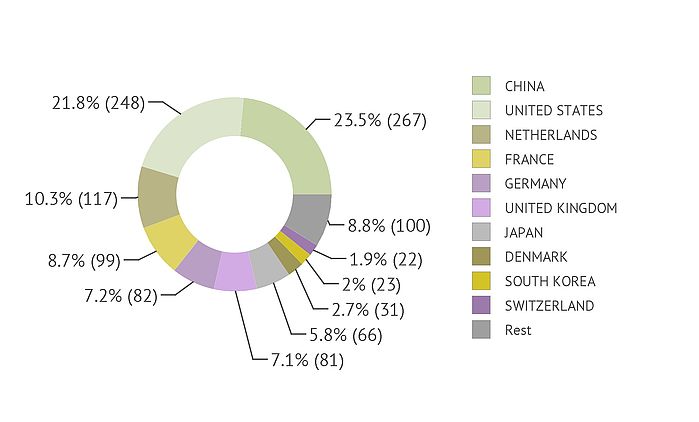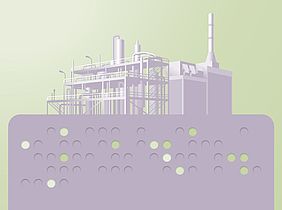The present review contains brief statistical information on patent applications published in 2017 in patent offices around the world regarding the field that concerns synthetic fuel production (synthesis gas; liquid fuel from gas, coal and biomass; methanol and its derivatives; other energy products of synthetic origin). As of the date of this publication the collection of patent applications found comprised 1112 documents from 29 patent offices, prepared by 399 applicants from 26 countries. This is approximately 20% of the documents less compared to the previous year.
The patent office of China became the leader by the number of registered patent applications in 2017 in this field – 296 documents, which comprised more than 29% of the total number of documents. The top three leaders also included patent offices of the USA and Brazil. Almost 90% of patent documents were filed in the top 10 patent offices. Compared to the previous year, noticeable changes took place in the list of leaders. Thus, the position of the patent office of Australia was taken by the patent office of Malaysia. The number of patent documents registered in the patent offices of Europe, Canada, South Korea, the USA and WIPO fell substantially. To a considerable extent the offices of China, Japan and Brazil retained their positions by the number of documents, with changes not exceeding 10%.
Distribution of patent applications, published by the top 10 patent offices
| Patent office | Number of documents, 2017 | Share of total, % |
|---|---|---|
| Canadian Intellectual Property Office | 33 | 3.3 |
| State Intellectual Property Office, China | 296 | 29.7 |
| European Patent Office | 92 | 9.2 |
| National Institute of Industrial Property, Brazil | 134 | 13.4 |
| Industrial Property Office, Japan | 48 | 4.8 |
| Korean Intellectual Property Office | 29 | 2.9 |
| Intellectual Property Corporation of Malaysia | 54 | 5.4 |
| Federal Service for Intellectual Property, Russia | 34 | 3.4 |
| United States Patent and Trademark Office | 175 | 17.5 |
| World Intellectual Property Organization | 103 | 10.3 |
Source: Advanced Energy Technologies
The representatives of China and the USA were the most productive by the number of registered applications – 23.5% and 21.8% of the total number, respectively. It should be noted that in the current year the leaders switched places compared to the previous year, nevertheless their aggregate share comprised more than 45% of inventions, both in 2017 and in 2016. The share of participation by the Netherlands and France in the patenting process rose substantially – by more than 5%, and by almost 5%, respectively. The patenting activity of representatives of Germany and Japan decreased slightly – by 3.6% and 2.9% of the total number, respectively.
Distribution of countries of the world by the number of resident applicants in patent applications
Source: Advanced Energy Technologies
The following patent offices were particularly popular among non-residents: Brazil with 132 documents, which is 99% of the total number of documents, registered in this patent office; the USA – 97 documents, or 55%; and China – 91 patent applications (31%). All off the applicants who patented their inventions in the patent offices of Malaysia and Australia were non-residents, while in the offices of Russia and Canada their share comprised 97% and 94%, respectively. In addition to resident applicants, the representatives of 19 countries of the world patented their inventions in the patent office of the USA; 16 countries in the office of Brazil; and 12 countries in the office of Malaysia.
More than 48% of the total number of patent applications revised in one way or another in virtually equal proportion were dedicated to Fischer-Tropsch processes or to Gas-to-Liquid technology in general. In addition, the interest of inventors was also attracted by Coal-to-Liquid technology, production of methanol and its derivatives, as well as to Biomass-to-Liquid. Similar proportions were seen the previous year.
In the vast majority of cases the technical solutions proposed in the patent applications concerned the problem of low efficiency of main processes. Among other problems, a fairly large number of inventions were aimed at solving High OPEX / Repair and replacement, High OPEX / Maintenance, High CAPEX / Development, as well as Low efficiency due to energy losses. The same problems were popular the previous year as well, and in similar proportions.
Distribution of technical problems in the patent applications found
Source: Advanced Energy Technologies
AOP - Administrative and organizational problems; HCD - High CAPEX / Development; HCE - High CAPEX / Equipment; HCG - High costs in general; HOM - High OPEX / Maintenance; HORR - High OPEX / Repair and replacement; LECR - Low efficiency due to catalyst replacement; LEEL - Low efficiency due to energy losses; LEFQ - Low efficiency due to feed quality; LEG - Low efficiency in general; LEMP - Low efficiency of main processes; LESP - Low efficiency of secondary processes; SES - Saving ecosystems; UP - Unclear problem; WEGC - Water, energy or gas consumption
The most frequently mentioned group of the International Patent Classification by WIPO in patent documents was C01B 3/00 (Hydrogen; Gaseous mixtures containing hydrogen; Separation of hydrogen from mixtures containing it; Purification of hydrogen) – in more than 10% of cases. In the previous year the most popular group was B01J 23/00 (Catalysts comprising metals or metal oxides or hydroxides), which was also in high demand the current year. C10G 2/00 (Production of liquid hydrocarbon mixtures of undefined composition from oxides of carbon), C10J 3/00 (Production of gases containing carbon monoxide and hydrogen, e.g. synthesis gas or town gas, from solid carbonaceous materials by partial oxidation processes involving oxygen or steam) and B01J 37/00 (Processes, in general, for preparing catalysts) were also among the groups of the International Patent Classification by WIPO having a share exceeding 5%.
Fischer-Tropsch synthesis and Fischer-Tropsch catalysts with presence in nearly 30% cases, as well as Syngas production in general, Primary technologies and Other methods of syngas production with more than 31% mentions noticeably stand out in the list of various technological processes for the production of synthetic fuel in the reviewed patent applications. Technological procedures involving Refining of products, Treatment of syngas and Methanol synthesis were considered in every twentieth patent application. Such technologies as Direct coal liquefaction, DME synthesis from syngas, Feedstock preparation were mentioned in patent documents very rarely, their shares didn't exceed 1% of the total number of mentions. Microchannel technologies (Microchannel syngas production and Microchannel Fischer-Tropsch) are still highly popular. In aggregate, they were mentioned in more than 5% of cases.
More detailed information on the methodology as well as on the results of patent researches in the most important fields of contemporary energy industry can be found at Advanced Energy Technologies.
